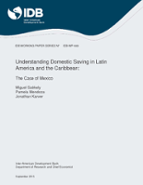Understanding Domestic Saving in Latin America and the Caribbean: The Case of Mexico
Date
Sep 2015
This study addresses why Mexico continues to show below-average economic growth rates in spite of displaying systematically higher domestic savings than other countries in the region. Using the wealth of relevant databases available for the country, the paper finds that a possible explanation is that household savings account for a majority of domestic savings, and that the main instrument used for savings is durable goods, which implies that savings are not directly injected into the financial system for fueling productive investment. The construction of a synthetic panel from household survey data shows that household savings in Mexico have a clear age-increasing trend and have been growing across generations during the past 30 years; it is thus probable that rates will increase in years to come. However, if those savings continue to elude the financial system, their influence on economic growth may remain limited.



